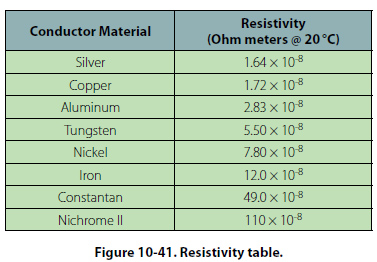Resistivity
Claimed by Christopher Lee -- Spring 2016 Resistivity is the measure of how difficult it is for a current to pass through a certain material at a certain temperature.
This quantity often measured in ohms per meter or [math]\displaystyle{ (\frac{Volts}{Amps\ Meter}) }[/math] is used to determine the resistance of a given conductor. Resistivity of an object is almost solely dependent on two factors, temperature and material. Resistivity unlike resistance is independent of the size or shape of a material.
The Main Idea
Resistivity is in its most basic form a constant for each material that says how easy it is for a current to pass through a given material. Some materials will more easily allow currents to pass through them. For instance it is almost twice as easy to have a current pass through copper as it is for it to pass through aluminum. This explains why most wires are made out of copper instead of aluminum.
A Mathematical Model
Resistance is often calculate from resistivity using the following equation [math]\displaystyle{ R = \frac{\rho L}{A} }[/math] where R is the resistance [math]\displaystyle{ \rho }[/math] is the resistivity L is the length and A is the cross-sectional area.
In a circuit the Electrical Resistance is then often used to calculate the current in a circuit using the following equation Ohm's law [math]\displaystyle{ I = \frac{|\Delta V|}{R} }[/math] where V is the voltage and I is the current and R is the resistance. In this equations voltage and resistance are independent variables and Current is the dependant variable. This law, while useful, only works for certain resistors called ohmic resistors.
Water Analogy
The relationship between resistivity and resitance can often be though of as a series of pipes. Electrical Resistance in a particular material is like pipes of varying diameter. The larger the pipe the easier it is for water to get through. The resitivity of the "pipes" never changes. What does change is the cross sectional area making it easier for "water" to pass through.
Resistivity of Materials
Every conductor has a natural resistivity that it relatively consistent at a given temperature. This number is calculated through experimentation. Here is a list of common conductors and their resistivity.
Temperature
In addition to each material having a different resistivity. The same materials at different temperatures have different resistivities. As materials heat up it becomes harder and harder for current to pass through them. This is because at the sub-atomic level. The nuclei are moving faster making it harder for electrons to move through.
Examples
3 examples of potential problems involving resistivity and resistance.
Simple
Question
An unknown ohmic resistor is attached to a 3V battery and the current is measured at 1 amp. Calculate the resistance of the unknown resistor.
Answer
Using the equation I=|dV|/R we can substitute is 1 for I and 3 for dV leaving us with the equation 1=3/R. Solving for R we come to the answer that the it must be a 3 ohm resistor.
Middling
Question
A cylinder of an unknown material has a resistance of 30 ohms. Another cylinder made of the exact same material is twice as long and has a radius that is twice as large. What is the resistance of this cylinder.
Answer
Given the equation [math]\displaystyle{ R = \frac{\rho L}{A} }[/math] we know that when the length is doubled the resistance must also double. In addition we know that when the radius is doubled, the cross section area must go up by a factor of 4. This means that the resistance would go down by a factor of 1/4. Putting both of those facts together know that R2 = R1 * 2 * 1/4 or R2 = 15 ohms.
Difficult
Question
A battery and resistor circuit is connected to a very sensitive ohmmeter is taken outside and left in the sun on a very hot day. what if anything will happen to its reading after being outside for a few minutes and why. Assume the battery is unaffected.
Answer
The current would be less that it was inside. Since the circuit was taken outside the resistor would heat up due to the sun. This would in turn cause its resistance to go up. When the resistance goes up and the voltage of the battery stays the same. due to Ohms Law the current must go down, resulting in a lower reading.
Connectedness
Resistivity is very important electrical engineers and others who work with circuits because it is important to understand how a circuit is going to work when outside of laboratory conditions. Users will expect their circuits to work the same whether in a cool air conditioned room or when exposed to extreme temperatures and Electrical Engineers must understand resistivity to know how it will react.
See also
Further reading
1. Matter and Interactions by Ruth Chabay and Bruce Sherwood
External links
Helpful Links
1. http://hyperphysics.phy-astr.gsu.edu/hbase/electric/resis.html
2. http://www.britannica.com/technology/resistance-electronics
3. http://www.cleanroom.byu.edu/Resistivities.phtml
4. http://www.nist.gov/data/PDFfiles/jpcrd155.pdf
5. http://www.regentsprep.org/Regents/physics/phys03/bresist/default.htm
Helpful Videos
1. https://www.youtube.com/watch?v=-PJcj1TCf_g
2. https://www.youtube.com/watch?v=J4Vq-xHqUo8
References
1. http://hyperphysics.phy-astr.gsu.edu/hbase/electric/resis.html
2. http://www.britannica.com/technology/resistance-electronics
3. http://www.nist.gov/data/PDFfiles/jpcrd155.pdf
4. http://www.regentsprep.org/Regents/physics/phys03/bresist/default.htm
5. http://forums.extremeoverclocking.com/showthread.php?p=4144637



